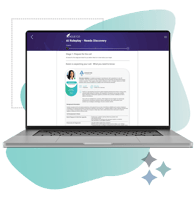Effective sales training is widely acknowledged as a critical success factor for sales organizations. But how many companies are truly excelling in this area? And what distinguishes those with highly effective sales training and development from the rest?
The answers may surprise you.
RAIN Group recently partnered with Allego to survey 242 sales professionals across various industries and regions. Our goal? To uncover the state of sales training and reveal what organizations with highly effective training and development do differently.
Our Top-Performing Seller research confirms that when sales training is done well, organizations experience dramatically better business results. Organizations with highly effective training see:
- Higher win rates
- Greater sales goal attainment
- More success achieving premium pricing
Yet a significant gap exists between recognizing the importance of sales training and implementing truly effective programs.
In this article, we'll dive into the key findings from our study and explore:
- What sets apart organizations with highly effective sales training
- The surprising factors that drive training effectiveness
- How you can foster a continuous learning culture
- Why and what to measure for training
- The role of technology in sales training
- Practical steps you can take to elevate your sales training and performance
Let's examine the data and uncover how your organization can join the ranks of the sales training elite.
Key Insights from Continuous Learning Research
- The Current State of Sales Training: Room for Improvement
- What Sets Highly Effective Training Apart
- Building a Culture of Continuous Learning
- Measuring Training Effectiveness
- The Role of Technology in Sales Training
- Bridging the Gap: From Onboarding to Continuous Learning
- Key Takeaways: Creating Effective Continuous Learning for Sales
- The Path Forward
The Current State of Sales Training: Room for Improvement
One striking finding from this study is that only 33% of respondents rate their organization's sales training and development as extremely or very effective in helping achieve strong sales performance and productivity. This means that a staggering 67% of organizations are falling short in their training efforts, potentially leaving significant performance gains on the table.
This gap in training effectiveness has real consequences. Organizations with highly effective sales training programs reported:
- Lower undesired turnover rates (33.8% vs. 45.5% for those with less effective training)
- 4.9x more likely to strongly agree their onboarding gets sellers productive quickly
- 3.5x more likely to strongly agree their training prepares sales roles to succeed
The stakes are high when it comes to sales training effectiveness. So what are the organizations with highly effective programs doing differently?
What Sets Highly Effective Sales Training Apart
Our research uncovered several key differences in how highly effective organizations approach sales training. Many of these methods can be applied with limited enablement budgets, making the most of your training and enablement investments.
1. Training Delivery Methods
While virtual training has become increasingly common, in-person, instructor-led training remains a hallmark of highly effective programs. In fact, 93% of organizations with highly effective training use in-person, instructor-led methods compared to only 65% of those with less effective training.
Delivery Methods for Highly Effective Training
% Selected

However, it's not an either/or proposition. Highly effective organizations also leverage virtual instructor-led training (66%) and virtual self-study (50%), suggesting that a blended approach yields the best results.
2. Online Learning Materials and Support
Organizations with highly effective training tend to provide a wide range of online learning materials and support, including:
- Sales tools, templates, and workbooks (73%)
- Recorded videos (63%)
- Online courses or program modules (61%)
Online Learning Materials and Support in Highly Effective Sales Training
% Selected

Compared to organizations with less effective training, they're also more likely to offer:
- Learning reinforcement activities (1.5x)
- Online coaching (1.4x)
- Roleplaying and simulations (1.3x)
To maximize training effectiveness, be sure to offer a diverse array of online learning resources and support tools. In addition to essential materials such as sales tools and videos, prioritize offering learning reinforcement, online coaching, and role-play simulations. This approach not only enhances skill acquisition, but also fosters deeper understanding and application.
3. Three Key Drivers of Effective Sales Training
A regression analysis identified three critical factors that drive sales training effectiveness.
3 Key Drivers of Effective Sales Training
% Relative Importance of Each Variable in the Model

- Regular Mentoring and Coaching: Organizations with highly effective training are 2.9x more likely to strongly agree that “mentoring or coaching is strongly encouraged on a regular basis.”
- Using Assessments to Identify Skills to Develop: Highly effective organizations are 5.5x more likely to use assessments proactively to identify which skills need development.
- Effective Onboarding Programs: Highly effective organizations are 4.9x more likely to have onboarding programs that get sellers productive quickly.
When developing your sales training, be sure to attend to these three factors.
4. Characteristics of Highly Effective Sales Training Programs
Beyond these key drivers, organizations with highly effective training share several important characteristics, including:
- Strong leadership support for continuous learning (2.2x more likely)
- Resources that prepare sales managers to motivate and coach their teams (5.2x more likely)
- Ongoing reinforcement to help people retain and apply new skills (4.8x more likely)
Our findings hint that organizations with the most effective sales training take a holistic approach to their training that starts with assessments to identify skills, is supported by leadership, and involves sales managers motivating their teams and offering regular mentoring and coaching. This level of support beyond the classroom, paired with ongoing reinforcement applying the new skills, ensures that learning translates to performance improvement.
Building a Culture of Continuous Learning
One of the most significant differences between organizations with highly effective training and the rest is their approach to continuous learning.
Highly effective organizations are 2.2x to 5.5x more likely to embrace each of these elements of a continuous learning culture.
Continuous Learning Culture
% Strongly Agree

This includes practices like delivering a series of training experiences over time, transitioning smoothly from onboarding to "everboarding," and encouraging accountability partners or peer review.
Highly effective organizations are also 2x to 3.3x more likely to implement each of five more tactical aspects of continuous learning.
Tactical Approach
% Strongly Agree

When training content is tailored to learners’ role, easy to apply to the scenarios they face, and delivered in the flow of work, where and when they need it, it's much more relevant and valuable. This approach bridges the gap from classroom to in-the-field application so skills build over time.
Measuring Training Effectiveness
Another key difference between organizations with highly effective training and those with less effective training is their approach to measurement. Organizations with the strongest training are significantly more likely to measure effectiveness using a variety of metrics.
Training Effectiveness Measures Used by Organizations with Highly Effective Sales Training
% Selected

- Facilitator feedback: 2.4x more likely
- Employee retention rates: 2x more likely
- Sales performance metrics: 1.7x more likely
- Assessments: 1.6x more likely
- Employee feedback: 1.3x more likely
Notably, organizations with less effective training are 13.8x more likely not to measure training effectiveness at all. We’ve noted the words of Peter Drucker before, “What gets measured, gets managed.”
Implementing robust measurement practices is critical to drive continuous improvement in your sales training efforts.
The Role of Technology in Sales Training
In today's digital age, technology plays an important role in enabling effective sales training. Our research found that 63% of organizations with highly effective training have invested in a sales learning and enablement platform. These platforms often provide key features that support continuous learning.
Highly effective organizations tend to make use of technology to deliver online training resources.
- Content is available when and where needed: 31% strongly agree, 2.1x more likely
- Learning content is available in the workflow (e.g., just-in-time learning, CRM integration): 20% strongly agree, 3.2x more likely
- Gamification and interactive elements are engaging (e.g., challenges, role-plays, simulations): 13% strongly agree, 3.1x more likely
- Sales playbooks or best practice guides are current and easy to access: 27% strongly agree, 2.8x more likely
While technology is clearly important, it's worth noting that even among highly effective organizations, there's room for growth in leveraging these tools to their full potential.
Bridging the Gap: From Onboarding to Continuous Learning
Another key differentiator of highly effective organizations is their ability to seamlessly transition from initial onboarding to ongoing development.
Thirty percent of organizations with the most effective training strongly agree that their onboarding transitions directly to "everboarding" (i.e., continuous learning) compared to only 7.6% of those with less effective training.

This focus on continuous development is key to long-term success as it ensures that sales professionals continue to grow, adapt, achieve, and contribute to a high-performing sales team.
Key Takeaways: Creating Effective Continuous Learning for Sales
Based on our research findings, here are eight recommendations for organizations looking to elevate their sales training and development efforts:
- Blend delivery methods: Combine in-person, virtual instructor-led, and self-study options for a comprehensive approach.
- Prioritize regular coaching and mentoring: Make these cornerstones of your sales training and development strategy.
- Foster a continuous learning culture: Secure strong leadership support to encourage ongoing skill development.
- Implement robust measurement practices: Use regular assessments and performance metrics to drive continuous improvement.
- Leverage technology strategically: Use learning platforms and tools to reinforce training and enable just-in-time learning.
- Bridge onboarding to continuous development: Ensure a seamless transition from initial training to ongoing learning.
- Customize and contextualize: Tailor training content to specific roles and apply it to real sales scenarios.
- Address common challenges proactively: Anticipate and plan for issues like time constraints and engagement.
The Path Forward
This research paints a clear picture: while many organizations are struggling with sales training effectiveness (67%!), there's a significant opportunity for improvement. By adopting the practices of highly-effective organizations—from embracing a culture of continuous learning to using technology and implementing robust measurement practices—companies can dramatically enhance the effectiveness of their sales training efforts.
The potential rewards are substantial: lower turnover, faster ramp-up times for new hires, and better-prepared sales teams for the long term. In today's competitive business landscape, these advantages can make the difference between meeting quotas and leading the market.
We encourage you to take a critical look at your own sales training and development programs. How do they measure up against the benchmarks set by highly effective organizations? Where are your opportunities for improvement?
Next Steps
Ready to take your sales training to the next level? Schedule a consultation with our team to discuss your specific needs and how we can help you implement these best practices.
Don't let your sales training efforts fall into the 67% that are underperforming. Take action today to create a culture of continuous learning and drive your sales performance to new heights.








